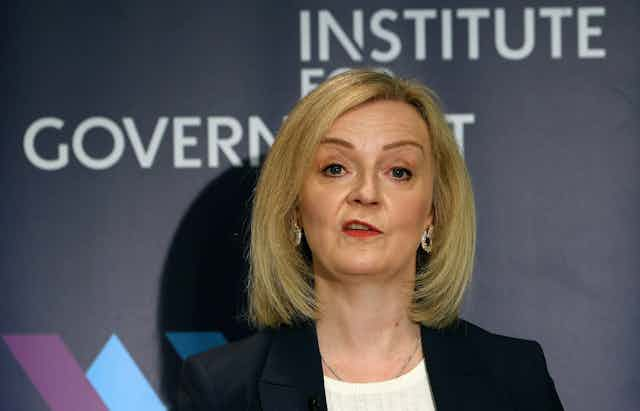All prime ministerial memoirs are about shaping legacies. “History will be kind to me,” Churchill is alleged to have said before writing his own six-volume history. “For I intend to write it.”
But among these memoir writers sits a sub-genre of leaders who need to do some pretty serious legacy shaping. Think Anthony Eden on Suez, Margaret Thatcher on the poll tax, Tony Blair on Iraq or David Cameron on Brexit.
There are several different approaches. You can claim it was actually all fine (Eden), blame everyone else or suggest it was all just starting to work (Thatcher), or muddy the waters (Blair, at his lawyer-like best).
Liz Truss has more explaining to do than most. She managed, in the space of just 49 days, to (almost) crash the economy and (almost) destroy the Tory party. She left office as the shortest serving prime minister in history.
In political terms, in just over a month, 13% of Tory voters switched to Labour. She began with a net favourability rating of +41 among Conservative 2019 voters and ended with -30.
Had an election been held at the end of her brief tenure, the Conservatives would have finished third. Rishi Sunak, though, should rein in his smugness – he’s currently only one point above Truss’s lowest ever score.
Where it all went wrong (according to the author)
Disappointingly, Truss begins her book by saying it is not a political memoir. She instead insists that her book is really about “saving the west”, though she admits she could “write a book” about what went wrong. However, she does try to explain what happened, veering between blaming everyone else, suggesting her plans would have worked given a proper chance and, perhaps most interestingly, pleading ignorance.
Truss points out, rightly, that she came to office with some disadvantages. She lacked support from Tory MPs and senior ministers (and it is true she did have the lowest level of support of any modern Conservative leader).
She was given no real honeymoon by the press. She complains of the short-termist, media driven culture in Downing Street (as did Blair) and the lack of structure or resources (see every prime minister since the 1970s).
Behind this is a deeper, less believable story. From the outset, Truss portrays herself a kind of continuous radical force, taking on the establishment as the valiant, lonely rebel.
In education she battled those who don’t wish children to read. As environment secretary she waged a two-front war against the Marxist-infected climate lobby without and colleagues with “climate fever” within. As trade secretary she bravely tries to reach former US president Donald Trump himself to push through the US-UK trade deal that was just within reach but was snatched away by establishment naysayers.
In Downing Street, Truss the radical is blocked, stymied and opposed at every turn by a group/coalition/alliance. In places, Truss identifies her opponents carefully. In her mini-budget, it was the Treasury, the OBR and Bank of England, which acted as a “three-headed hydra” – with her own MPs cheering them on. All these bodies predicted (but, Truss implies, threatened to make real) economic chaos if Truss pushed on.

Elsewhere, though, it gets more Trumpian and vague. Truss was stopped, “ambushed” and held “at gunpoint” by the “Deep State”, the “anti-growth coalition” and “declinists”. She was defeated by a progressive and Marxist alliance that stretches from her fellow Oxford students to US president Joe Biden and philosopher Michel Foucault (whose work is referenced only via encyclopaedia Britannica. Tut tut).
What not to do
For all this, however, Truss’s book offers some important lessons for future prime ministers, albeit more in terms of what not to do than how to do the job well.
Prime ministers, for a start, need to listen. All prime ministers stop listening, eventually but it seems Truss never even started.
Even before becoming prime minister, her own husband warned it would “all end in tears”. Truss reveals that her agent – and it’s hard to believe this made it into the book – said “I should run – but he thought it would be best if I came second”.
And, as we know, the Queen warned Truss to “pace yourself”. As we also know, she didn’t.
Prime ministers need to make good use of time. Napoleon famously said that he would give someone anything, except time. Truss’s book captures the sheer, confusing rush of events.
The impression is that Truss had neither the will or ability to stop and think. She left herself no time to plan. She had no time for warnings and, crucially, no time for forecasts from the Office for Budget Responsibility.
Her “charm offensive” with her own MPs or officials came far too late. She cites her inability to get ahead of the news cycle as the crisis erupted as being “fatal”.
Finally, prime ministers need to understand. The crucial sentence, that sums up the Truss premiership, comes, appropriately, in chapter 13. In reference to liability driven investments, which, for her, were the key to the financial crisis surrounding her premiership, she writes that she “struggled to understand and explain what was happening”.
How, you ask, could a prime minister not know about, or bother to find out about something she believed to be so important? This sense of reckless “not knowing”, and not trying to find out, permeates her whole book. Truss admits coming to office “underprepared”, but then seizes control, and pushes half-baked and untested ideas without thinking, asking or checking.
What’s more, a prime minister needs to understand the responsibilities of the job. Asking “Why me? Why Now?” when informed of the death of the Queen only demonstrates how little Truss understood about the scale of the modern role.
A good politician must be able to see around corners. Buried deep in this book is the real story. Truss lasted 49 days because she never even looked.

